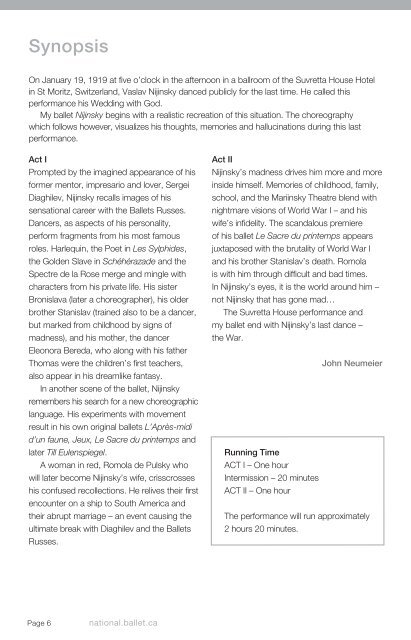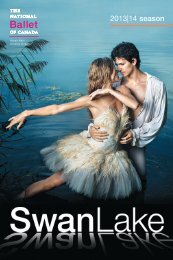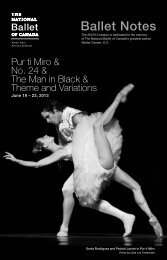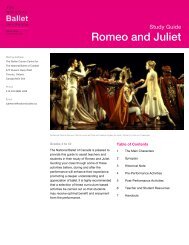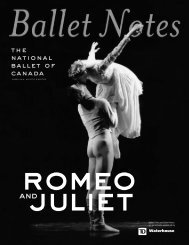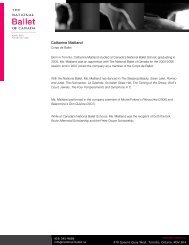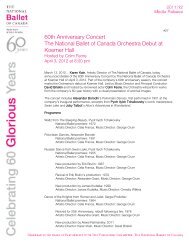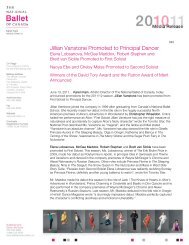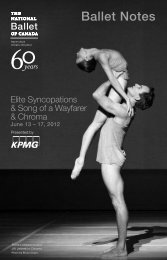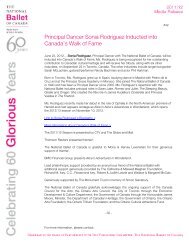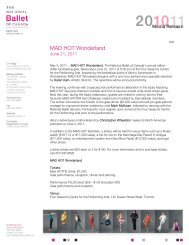Nijinsky - The National Ballet of Canada
Nijinsky - The National Ballet of Canada
Nijinsky - The National Ballet of Canada
You also want an ePaper? Increase the reach of your titles
YUMPU automatically turns print PDFs into web optimized ePapers that Google loves.
Synopsis<br />
On January 19, 1919 at five o’clock in the afternoon in a ballroom <strong>of</strong> the Suvretta House Hotel<br />
in St Moritz, Switzerland, Vaslav <strong>Nijinsky</strong> danced publicly for the last time. He called this<br />
performance his Wedding with God.<br />
My ballet <strong>Nijinsky</strong> begins with a realistic recreation <strong>of</strong> this situation. <strong>The</strong> choreography<br />
which follows however, visualizes his thoughts, memories and hallucinations during this last<br />
performance.<br />
Act I<br />
Prompted by the imagined appearance <strong>of</strong> his<br />
former mentor, impresario and lover, Sergei<br />
Diaghilev, <strong>Nijinsky</strong> recalls images <strong>of</strong> his<br />
sensational career with the <strong>Ballet</strong>s Russes.<br />
Dancers, as aspects <strong>of</strong> his personality,<br />
perform fragments from his most famous<br />
roles. Harlequin, the Poet in Les Sylphides,<br />
the Golden Slave in Schéhérazade and the<br />
Spectre de la Rose merge and mingle with<br />
characters from his private life. His sister<br />
Bronislava (later a choreographer), his older<br />
brother Stanislav (trained also to be a dancer,<br />
but marked from childhood by signs <strong>of</strong><br />
madness), and his mother, the dancer<br />
Eleonora Bereda, who along with his father<br />
Thomas were the children’s first teachers,<br />
also appear in his dreamlike fantasy.<br />
In another scene <strong>of</strong> the ballet, <strong>Nijinsky</strong><br />
remembers his search for a new choreographic<br />
language. His experiments with movement<br />
result in his own original ballets L’Après-midi<br />
d’un faune, Jeux, Le Sacre du printemps and<br />
later Till Eulenspiegel.<br />
A woman in red, Romola de Pulsky who<br />
will later become <strong>Nijinsky</strong>’s wife, crisscrosses<br />
his confused recollections. He relives their first<br />
encounter on a ship to South America and<br />
their abrupt marriage – an event causing the<br />
ultimate break with Diaghilev and the <strong>Ballet</strong>s<br />
Russes.<br />
Page 6 national.ballet.ca<br />
Act II<br />
<strong>Nijinsky</strong>’s madness drives him more and more<br />
inside himself. Memories <strong>of</strong> childhood, family,<br />
school, and the Mariinsky <strong>The</strong>atre blend with<br />
nightmare visions <strong>of</strong> World War I – and his<br />
wife’s infidelity. <strong>The</strong> scandalous premiere<br />
<strong>of</strong> his ballet Le Sacre du printemps appears<br />
juxtaposed with the brutality <strong>of</strong> World War I<br />
and his brother Stanislav’s death. Romola<br />
is with him through difficult and bad times.<br />
In <strong>Nijinsky</strong>’s eyes, it is the world around him –<br />
not <strong>Nijinsky</strong> that has gone mad…<br />
<strong>The</strong> Suvretta House performance and<br />
my ballet end with <strong>Nijinsky</strong>’s last dance –<br />
the War.<br />
Running Time<br />
ACT I – One hour<br />
Intermission – 20 minutes<br />
ACT II – One hour<br />
John Neumeier<br />
<strong>The</strong> performance will run approximately<br />
2 hours 20 minutes.


